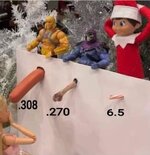You raise a fair point about large calibers for dangerous game, but it makes me question whether a .223 really wouldn’t work on something like a grizzly (no idea on African dangerous game). There’s documented evidence of small calibers killing grizzlies, and with the right bullet—a fast-expanding, well-constructed design—it could create significant tissue damage, leading to incapacitation.A couple of thoughts:
Point 1 - 500 pages, if that is the real number, great. Evidence is subjective and consider the source, there have been ballistics charts for nearly every single caliber available, large and small. This is NOT just a small caliber thing
Point 2: The documentation is available in thousands and thousands of pages, articles, anecdotal evidence and more than 300 years of hunting and shooting. It may not all be here but you dont have to look far to find it.
To your larger question than yes, a standard 30 Nosler provides ballistic advantage over a standard 243. Period dot.
There are places that a large caliber is critical - taking it to the highest level, I would not want to hunt a charging grizzly bear or a Cape Buffalo with a 223. Ever...
If both bullets hit the same spot, my question has always been the same - why is it bad to have more of a good thing?
Add to that the ability to fire multiple well-placed shots quickly due to the low recoil of a .223, and in theory (not saying I’d want to test this in a high-stakes situation), shouldn’t it work as well—or possibly better—than a single slower follow-up from a magnum?
I’m genuinely curious here, because if the .223 delivers sufficient tissue disruption and the shooter can get multiple shots on target, isn’t the idea that it “wouldn’t work” more about perception and tradition than reality? Of course, there’s the margin for error to consider, but I’d like to hear more thoughts on this, especially from those who’ve seen small calibers used in extreme situations.



